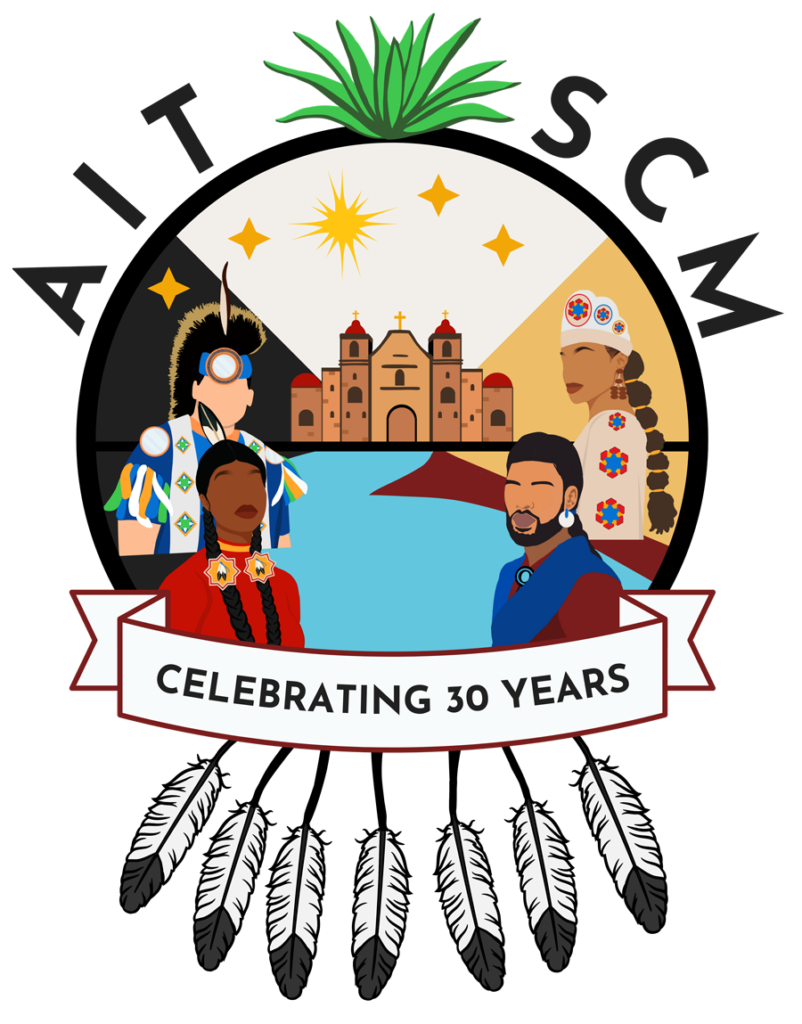
12-30-2022

Ramon Vasquez y Sanchez stands among some of his original works from his decades of painting and researching historic events throughout Bexar County. Credit: Scott Ball / San Antonio Report
San Antonian Ramon Vasquez y Sanchez has been many things: an advocate for indigenous Americans, an activist for social justice and Chicano rights, an agitator against injustice and an ardent preserver of local and regional history.
He has also been an artist, working diligently across seven decades in his favored mediums of oil and acrylic paint, pencil, pen and ink, and silkscreen.
This spring, a retrospective of his artwork from the 1950s through his current works will go on display at the Spirit Waters Art Gallery inside the new American Indians in Texas at the Spanish Colonial Missions (AIT-SCM) complex on East Commerce Street.
Vasquez y Sanchez’s son, AIT-SCM Executive Director Ramon Juan Vasquez, hopes his father’s commitment to fighting injustice will be evident in the paintings, drawings and prints.
“Taking a look at his fight for justice over the years, that’s what has informed all of his art,” Vasquez said.
Much done, much to do
Though the whereabouts of many Vasquez y Sanchez artworks is unknown, he and family members maintain a sizable collection of portraits, maps he crafted in his role as a member of the Bexar County Historical Commission, images of the five Franciscan Missions that lend identity to San Antonio’s history, and fanciful psychedelic paintings that link ancient Mesoamerican cultures to the cosmos.
The exhibition will be in sections, Vasquez said, representing each of these themes, and archival materials from his father’s extensive collections will inform the content of the paintings.
In fact, the veritable mountain of archival materials is holding up the show, intended to coincide with the grand opening of the new AIT-SCM center.
The opening was originally slated for December, but Vasquez and archivist Rudy De La Cruz continue to comb through hundreds of photographs, newspaper articles, writings, books and artworks now housed in the same building as the Spirit Waters gallery and an AIT-SCM crafts store.
During a visit to the Vasquez y Sanchez household on the near East Side, the 82-year-old artist mused that he hopes he lives to see the opening of the show, which Vasquez said might be in late February or possibly March, if the three men can complete their task by early spring.
Humanizing history
The quaint home is filled with the art of Vasquez y Sanchez and his wife Maria Chavez, as well as family portraits painted by her brother Roberto Robledo.
Many of Vasquez y Sanchez’s scenes will be familiar to San Antonians, depicting the five Missions and such notable settings as the Spanish Governor’s Palace. What sets these apart is Vasquez y Sanchez’s desire to humanize the old churches and farmlands that surrounded them with figures of the people who lived and worked there hundreds of years ago.
Without the figures, Vasquez said, these places would “look like relics of the past;” his father aims to remind everyone that they were once the homes of real human beings.
Rather than the dour black-and-white of historical photographs, the painting of the Spanish Governor’s Palace is foregrounded with several colorfully dressed families chatting with a soldier amid a lush green garden and fountain.
Several images depict what is now Main Plaza, but with the original one-story San Fernando Cathedral in the background. As with each image of what are primarily known as historical places, Vasquez y Sanchez includes contemporaneous figures.
Multiple Alamo paintings show the original facade without its famous curved crest, and with the families who gathered crops from the mission’s fields.
“The people that lived in the Alamo are part of the Alamo,” he said. In other Alamo paintings, he portrays the noble Mexican soldiers who defeated rebel Texan occupiers.
“Instead of putting the three heroes,” Vasquez y Sanchez said of the usual depictions of Crockett, Travis and Bowie, “I put the Mexican heroes.”
“Nobody ever dared to do something like that, you know, for the Alamo, until this guy came [around],” Vasquez said.
Deep connections
In his personality and artwork, Vasquez y Sanchez also displays a lighter side.
One Alamo painting contains a blood-colored sky that includes a helicopter, which appears anachronistic until the artist explains he’s depicting the 1969 movie Viva Max, a disturbingly lighthearted tale of a modern-day Mexican army general returning to San Antonio to take back Santa Anna’s lost prize.
Another painting, of a cemetery scene circa the 1850s, shows just how deeply connected Vasquez y Sanchez’s family is to San Antonio and Bexar County, long before those settlements were named.
The artist explained that two of the figures, a girl dressed in a yellow tunic and red skirt seated next to a woman in white atop the stone fence of the Campo Santo cemetery, are his grandmother Maria Sanchez and great grandmother Matilda Polanco.
The two are visiting relatives buried in the cemetery of the original Mission San Antonio de Valero, as the Alamo was first known. Its burial ground was located in what is now Milam Park and the Santa Rosa Hospital, Vasquez said.
As a self-appointed historian of pre- and post-revolutionary Mexico, San Antonio de Bejar, the Alamo, the Texas Republic and the Chicano presence in the Southwestern U.S., Vasquez y Sanchez said his intention is to paint history with a vivid sense of life.
That way, he said, “you get people to see it.”
Follow the progress of AIT-SCM toward the grand opening of its new complex on its Facebook page, and see a gallery of Vasquez y Sanchez’s artwork on his personal page.
To read more click here
